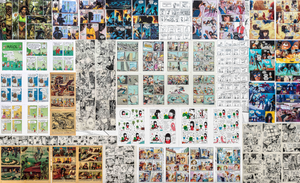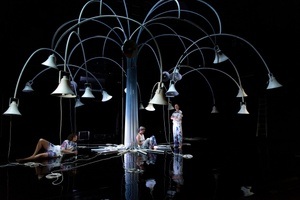Key Operators
In the organizer's words:
Exhibition with Elsi Giauque, Johanna Gonschorek, Michèle Graf & Selina Grüter, Pati Hill, Charlotte Johannesson, Lotus L. Kang, Alison Knowles, Beryl Korot, James Tilly Matthews, Katrin Mayer, Johannes Porsch, Radical Software, Bea Schlingelhoff, Marilou Schultz, Johanna Schütz-Wolff, Iris Touliatou
Program of events with Claire L. Evans, Lynn Hershman Leeson, Sadie Plant, Johannes Porsch
The exhibition Key Operators. Weaving and Coding as a Means of Feminist Historiography focuses on the link between female labor and technological progress. The systems inscribed in weaving and programming serve as a starting point to create alternative ways of looking at gender and work. The group exhibition brings together cross-generational artistic positions - and thus historical as well as newly conceived works - that deal with the concept of weaving and its significance for the development of computer technology on a concrete, metaphorical and linguistic level.
The computer has been linked to the history of textiles ever since weaving became a "programmed" mode of production in the course of industrialization in the late 18th and early 19th centuries. The mathematician Ada Lovelace (1815-1852) plays a special role in this. She recognized the potential of the punched cards used in the first mechanical looms - the so-called Jacquard looms - and transferred their system (hole / no hole) into a code of zeros and ones. This makes her a pioneer in the history of programming. So how is it that weaving is still perceived as a traditionally female activity, while coding is seen as a male field? The historically significant role that women and their work played in the development of computer technology is often forgotten or relegated to the margins of history. As Sadie Plant notes, "Where all the main roads of life are labeled 'male,' and the woman has no choice but to be a woman,' men were the ones who could do it all. Women [...] served as an 'infrastructure' of our society and our culture ... that remains unrecognized as such'."[1]
In reference to this idea, the title of the project is derived from a gender-specific division of labor: When photocopiers were introduced into offices in the late 1940s, they were only allowed to be operated by trained "key operators". Tasks related to the machines were considered menial office work and were usually assigned to women. The title also offers other possible readings: "key" in the sense of a central figure, emphasizing the important role of women both in the establishment of weaving as an independent art form and in the development of computer technology; "key" also as a button on the computer or as the pedal of a loom. The artistic and theoretical positions in Key Operators understand weaving and coding as critical metaphors. The various contributions function as narrative threads that traverse different contexts and link different narrative methods in order to search the peripheries of official historiography for their absences. In this context, the loom and the computer are seen as allies, so to speak, to look at the margins of history that often create the conditions for its writing.
Curator: Gloria Hasnay
together with: Maurin Dietrich
Assistant curators: Lucie Pia & Lea Vajda
Price information:
5 EUR regular 3 EUR Pensioners, students, people with disabilities, young people up to 18 years 1 EUR unemployed, students of fine arts, art history, film Free admission km members, members of ADKV, ICOM, children up to 12 years













